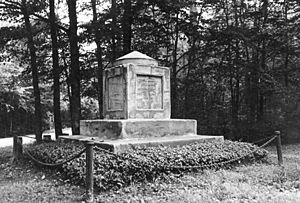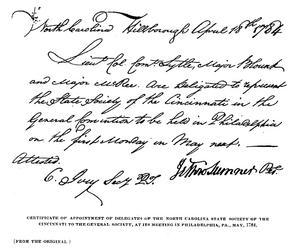Jethro Sumner facts for kids
Quick facts for kids
Jethro Sumner
|
|
|---|---|
| Birth name | Jethro Exum Sumner |
| Born | ca. 1733 Nansemond County, Virginia |
| Died | ca. March 18, 1785 (aged 52) Warren County, North Carolina |
| Buried | (36°07′56.0″N 79°50′33.1″W / 36.132222°N 79.842528°W) |
| Allegiance |
|
| Service/ |
|
| Years of service | 1758–1783 |
| Rank | Brigadier General |
| Commands held |
|
| Battles/wars | French and Indian War |
| Signature | |
Jethro Exum Sumner (born around 1733 – died around March 18, 1785) was an important officer in the Continental Army during the American Revolutionary War. He was born in Virginia. Sumner started his military career in the French and Indian War, fighting for Virginia.
After that war, he moved to Bute County, North Carolina. There, he bought a lot of land and ran a tavern. He also served as the Sheriff of Bute County. When the American Revolution began, he strongly supported the American side, known as the Patriots. He was even chosen to be part of North Carolina's Provincial Congress.
In 1776, Sumner became the commanding officer of the 3rd North Carolina Regiment in the Continental Army. He fought in both the southern parts of the war and the Philadelphia campaign. He was one of five brigadier generals from North Carolina in the Continental Army, serving from 1779 to 1783. He fought bravely in the Battles of Stono Ferry and Eutaw Springs. However, he often got sick, which sometimes meant he had to do office work or recover in North Carolina.
Later, when fewer North Carolinians were in the Continental Army, Sumner became a general in the state's militia. But he resigned because another general from Maryland was given overall command. At the end of the war in 1783, Sumner helped start the North Carolina chapter of the Society of the Cincinnati, a group for officers. He became its first president. He passed away in 1785, owning a lot of land and other property.
Contents
Early Life and First War Service
Jethro Sumner was born in Nansemond County, Virginia, in 1733. His parents were Jethro and Margaret Sullivan Sumner. His family had lived in Nansemond County since 1691.
From 1758 to 1761, during the French and Indian War, Sumner was a lieutenant in Virginia's army. He served in Pennsylvania under William Byrd III. On November 25, 1758, Sumner helped capture Fort Duquesne. In 1760, he became the commander at Fort Bedford in Pennsylvania.
After his army unit was disbanded in 1761, he went back to Nansemond County. Between 1761 and 1764, he moved to Bute County in North Carolina. He married Mary Hurst from Granville County. They had three children together. One daughter, Mary, later married Thomas Blount, who became a member of the United States House of Representatives.
Sumner owned a lot of land in Bute County, which he got through his wife's family. He also owned a tavern there, which he may have run himself. From 1772 to 1776, he worked as the sheriff of Bute County. He quit this job when he became an officer in the American Revolutionary War. Sumner was very active in the protests before the Revolution. He believed that America would have to separate from Great Britain.
Fighting in the American Revolutionary War
In 1775, the North Carolina Provincial Congress decided to create militia forces across the state. They set up six militia areas, and Sumner's home was in the one around Halifax.
Soldiers in the militia signed up for six months at a time. Sumner was chosen to be a major in the Halifax District militia. He was told to train his men for the upcoming war. From August to September 1775, he represented Bute County at the Third North Provincial Congress. In November 1775, Sumner called his militia to active duty. They marched north to join Robert Howe in capturing and later burning Norfolk, Virginia.
Southern Battles in 1776
On April 4, 1776, the North Carolina Provincial Congress chose Sumner to be a colonel. This made him the commanding officer of the 3rd North Carolina Regiment. He likely helped defend Charleston against a British attack in 1776. After that, he was involved in plans by Major General Charles Lee to invade British Florida.
The planned invasion of Florida did not happen. In September 1776, Sumner left his regiment in Savannah, Georgia, to go back to North Carolina and recruit more soldiers.
North to Philadelphia and Valley Forge
In early 1777, Sumner took command of the 3rd North Carolina regiment again. He marched his unit north to join George Washington in the Philadelphia campaign. For much of 1777, he and his men stayed with the main Continental Army at Morristown, New Jersey. They trained regularly and had their weapons checked and fixed. Many of the North Carolinians had very poor muskets, so many had to be thrown away.
Sumner and his regiment fought in the Battles of Brandywine and Germantown. They spent the cold winter of 1777 to 1778 at Valley Forge with Washington's army.
After General Francis Nash died at Germantown, his North Carolina brigade needed a new general. Sumner himself became sick in early 1778 and had to go home to get better. While recovering, he continued to recruit soldiers in North Carolina. Because there weren't enough soldiers, North Carolina's regiments were combined in February 1778. Sumner's 3rd Regiment joined with the 5th North Carolina Regiment.
Becoming a General and Fighting in the Carolinas
North Carolina believed it should have more generals. On January 9, 1779, the Continental Congress made Sumner a brigadier general. He was ordered to join General Benjamin Lincoln in South Carolina.
On June 20, 1779, Sumner led a Continental Army brigade at the Battle of Stono Ferry. His troops attacked the British and pushed back some German soldiers. However, the American troops started to run out of ammunition, so General Lincoln ordered a retreat. After this battle, Sumner became sick again. He went back to North Carolina to recover and continued to recruit troops. He also had to find soldiers who had left the army and bring them back to duty.
Leading the Militia
After the siege of Charleston in May 1780 and the Battle of Camden in August, most of North Carolina's Continental Army units were destroyed. Many soldiers were killed or captured. Sumner was in North Carolina recruiting during this time. Instead of rebuilding the Continental Line, North Carolina decided to rely on its militia to defend the state. In September 1780, Sumner temporarily took command of the Hillsborough District Brigade.
The North Carolina Board of War later removed the state's top militia commander. They gave command of the militia to General William Smallwood from Maryland. Sumner was also upset when Smallwood was given command of the few remaining North Carolina Continental soldiers. Sumner resigned from his militia command in October 1780. He then returned to serving in the Continental Army.
Back with the Continental Army
Sumner next served under General Nathanael Greene, who arrived in the southern states in December 1780. Greene told Sumner to recruit more Continental soldiers from North Carolina. On June 2, 1781, Greene ordered Sumner to join him in South Carolina. Sumner arrived on August 1 with 350 new recruits. Even though North Carolina had a draft law, the number of men under his command changed daily because soldiers would leave.
On September 8, Sumner's regiments were on the right side of the Continental Army at the Battle of Eutaw Springs. His units were very important in stopping several British attacks. General Greene praised the North Carolinians, saying they "fought with a degree of obstinacy that would do honor to the best of veterans."
After his success at Eutaw Springs, Greene made Sumner the commanding officer of Continental Army forces in North Carolina in 1781. Greene wanted him to help get the military situation in the state under control. After late 1781, fighting between the British and Continental armies mostly stopped. Sumner sometimes failed to send reports to Greene for several months, partly because he kept getting sick.
Later Life and His Legacy
After the war ended in 1783, Sumner went back to Bute County. The county had been renamed Warren County after Joseph Warren, a hero from the Battle of Bunker Hill. It seems Sumner's wife died sometime between 1781 and 1785. For his service in the Continental Army, he received a land warrant on October 23, 1783. This was payment for 84 months of service. Sumner helped create North Carolina's chapter of the Society of the Cincinnati in October 1783. He was its first president.
Sumner died in Warren County between March 15 and March 19, 1785, when he was 52 years old. When he died, he owned about 20,000 acres of land in North Carolina and Tennessee. He also owned 35 enslaved people. He was first buried about 8 miles outside of Warrenton. But in 1891, his remains were moved to the Guilford Courthouse Battlefield. They were buried under a monument there. In March 2012, a driver hit Sumner's monument, almost destroying it. The monument was fixed by May 2012, and Sumner was reburied in a public ceremony. Sumner County, Tennessee, was named after him, even though Sumner never visited the county.





